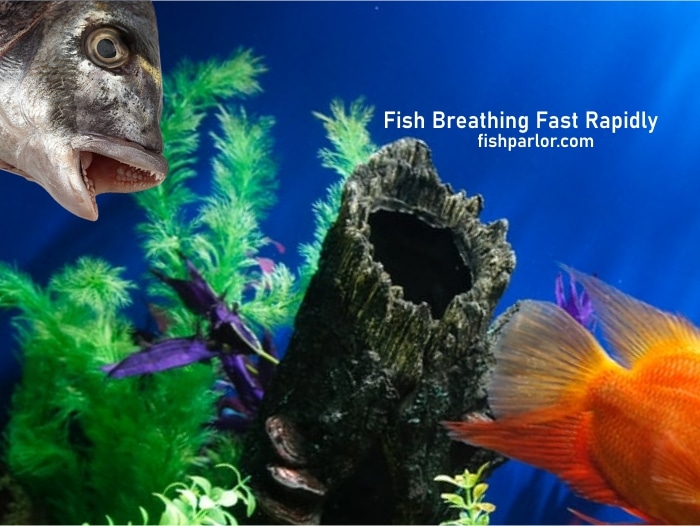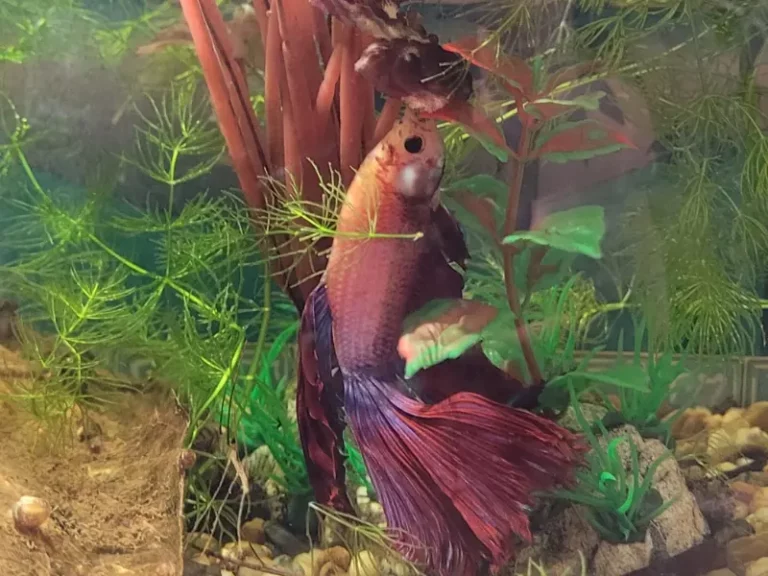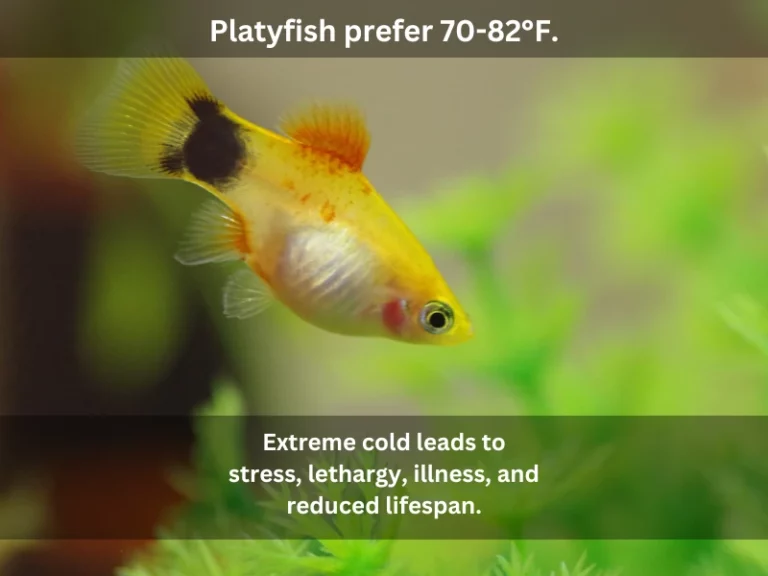When a fish breathes fast, heavy, or rapidly, the gills cover will also move at the same pace. The face becomes slightly or much bigger (depending on the specie) when its breathing pattern is faster than usual.
Fish may breathe fast or rapidly due to low oxygen levels, overcrowding, fighting, and unsuitable water temperature. Rapid or heavy breaths can be observed by checking the gill cover/operculum movements.
The gill cover is a flexible bony flap safeguarding gills against harm. Gills are in the form of lines. Just like your lungs, it is a challenge to see the gills of a fish since they are not in the open.

7 reasons why a fish may breathe faster, heavily, or rapidly
Observing normal breathing patterns is important. This will help you know when it has changed. Before solving the situation, you have to find the reason. Therefore, here are some common causes of rapid breathing:
1. Stress
Any fish will change its breathing pattern when stressed. This can be either fast or slow, depending on the causative factor. For example, male guppies fight alot, and the weaker ones will always breathe fast as they swim to safety.
Stressful situations not only cause fast breathing but also trigger the release of stress hormones. Too much of those hormones can affect the fish well being. According to the National Centre of Biotechnological Information, “In fish, the catecholamine hormones adrenaline and noradrenaline are released into the circulation, from chromaffin cells, during numerous ‘stressful’ situations.”
Stress can also trigger the release of cortisol, which reduces the production of white blood cells that protect the fish from infections. Stress sources in the tank include poor handling of the fish, poor water conditions, and bullying by aggressive, territorial tank mates. If the attacks persist, the isolation of fish like guppies can work and save the situation.
2. Giving birth or egg-laying
When a female fish is about to lay eggs or deliver, they tend to breathe fast. Just like any living creature, the females need extra energy. This triggers fast breathing that increases the amount of oxygen intake to sustain the body’s demands.
Ideally, there should be no concern if your fish is egg-laying or giving birth. But, ensure the conditions in the tank are favorable for a less stressful process of laying eggs or giving birth.
A clear sign of a fish giving birth is the presence and distribution of fry throughout the tank environment. Some fish species, like angelfish and gouramis, lay eggs for external fertilization and hatching.
3. Water change
Fish breathing fast after a water change is something you need to expect. The gasping for air happens even during a water change. Heavy, fast breathing is due to changes or fluctuations in water oxygen, contents, or conditions that can stress and shocks the fish.
The rapid breathing will stop as long as the water conditions become favorable after a few minutes or hours. If the fast breathing continues for hours after a water change, there is something wrong with the fish.
4. Temperature shock
Most fish species require a specific temperature range for healthy, happy living. For example, guppies can tolerate a temperature range of about 74 F to 90 F. If the temperature fluctuates or becomes unfavorable, the fish can have breathing difficulties before it dies.
A higher tank temperature burns and eliminates almost all the dissolved water oxygen. The fish will breathe fast without sufficient oxygen while trying to get enough.
Constantly monitor the temperature of the water and adjust it according to the required levels. Use a thermometer to measure the water’s hot or cold status.
what to do
Heaters and sources of light are great for increasing the water temperature. To gently lower the temperature, add cold water or float an ice bag on the water. Adjusting the water temperature should be done to avoid heat or cold shock.
Change about 10 to 15% of the water every week to eliminate waste and toxic gasses in the water. If your tank is congested, replace 25-30% of the water weekly.
Do not place your aquarium near the window because the sudden temperature change may cause a new tank syndrome. The water inside the aquarium may get too hot or cold, depending on the day’s weather.
5. Inadequate levels of oxygen
A fish breathing fast, especially at the water surface, may be due to insufficient dissolved oxygen in the aquarium. Poor water quality promotes low oxygen levels and ammonia poisoning, leading to stress.
Causes of insufficient oxygen include overstocking, high accumulation of waste, high water temperature, live plants, chemicals, stagnant water, and algae overgrowth. Bacteria and algae rely heavily on oxygen to grow and regulate the toxic level of the tank’s waste. Also, live plants consume oxygen and release carbon dioxide without exposure to light and during the night.
A fish with less oxygen tends to be slow and sluggish, have less or no appetite, and breathe heavily. In some cases, weakfish may be victims of cannibalism. Lower oxygen levels and higher carbon dioxide and ammonia can alter their breathing patterns which always happens when they are about to die.
6. Constipation
Constipation is also a leading cause of heavy breathing and illness in fish. A bloated belly indicates an inability to pass poop as usual. Issues with the swim bladder, resulting in difficulty maintaining balance in the tank’s water, may also cause breathing issues.
In most cases, diseases that make fish swim on their sides tend to alter their normal breathing patterns. This is often noticed in gouramis, goldfish, and many other fish species.
7. Infections or illness
Poor conditions in any habitat, like dirty water with extra salt, poor nutrition, and aeration, can change the breathing pattern of a fish. While in an aquarium, several diseases can attack a fish. Attacks from anchor worms, bacterial infections, kidney disease, constipation, tumors, and ich can be culprits.
For instance, when the spot disease or ich attacks the gills and skin, you will see a greyish tint or shade on them. Moreover, the fish will not be interested in eating, stay closer to the water surface more often, and move less as it feels tired while gasping for breath.
The white spot disease attacks the gills and reduces their normal functioning significantly. Any fish with compromised gills will have labored, fast breathing.
How to know if a fish is struggling to breathe
You can check for unusual irregular gill movements if a fish is struggling to breathe. The only way to know what’s normal and what’s not is to observe them regularly for at least 10-15 minutes every week.
- Breathing patterns vary in different fish species. In most cases, a fish not struggling to breathe has about 20-80 gill movement in a minute. But, if its gill cover moves more than 80 times per minute, it struggles to breathe.
- A fish struggling to breathe swims up and spends much of its time on top of the tank. If this happens, check on oxygen flow, attacks, or gill disorders that cause breathing difficulties.
Infectious illnesses and poor water conditions are the leading causes of stress and breathing struggles in fish. The stressors make the gills produce mucus to protect the fish’s health and cope with the stressful situation.
The release of mucus leads to the shielding of the gills. As a result, direct contact between water and gills barely exists. That affects the ability of your fish to get oxygen from the water through the mouth and into the gills. Increased production of mucus makes a fish breathe rapidly/fast.
Fish breathing fast and not eating
Fish breathing fast and not eating are common signs of trouble in the tank, like stress. Stress may come from;
- Aggressive tank mate
- Illness or infection
- The process of egg-laying or giving birth
- Temperature shock
- Poor water quality
- Rough handling during transportation.
When you notice your fish breathing fast and not eating, look for the above causes and eliminate them. For instance, if you have transported your fish in a manner that has made them stressed, ensure they have enough time to relax and get their breath back. Do not expose the fish to further sources of stress.
What to do if a fish is breathing fast, heavily, or rapidly
There are many solutions to the various causes of fish’s fast, heavy, and rapid breathing. Subsequently, below are some things to do if your fish has a fast-breathing issue.
- If there is ongoing ammonia poisoning, apply a chemical pH balancer inside the tank to neutralize the toxic levels of ammonia.
- Perform frequent water changes every few days or per week to remove rotting organic matter and wastes.
- Maintain correct water conditions, including temperature, hardness, and pH.
- Ensure the tank has enough beneficial bacteria in the tank’s filter for converting toxic gasses into safe forms.
- Improve the supply of oxygen in the water. Use a waterfall filter to produce waves to promote water aeration.
- Separate fighting fish.
In most cases, fish breathe fast when stressed. Causes of fast breathing are an illness, the process of giving birth, temperature shock, or inadequate oxygen levels in the aquarium.
An aggressive tank mate may also cause a weak fish to breathe fast and heavily due to tension. If the number of males is too much, females will constantly run around for fear of bullying, attacks, and extreme breeding. Weaker fish are soft targets for more aggressive, territorial fish species.
In conclusion, pay close attention to how the fish in your tank behaves and monitor the tank environment. That will allow you to identify heavy, fast breathing early. By doing that, you will find yourself in a better position to solve any current issue before your fish is seriously affected.
References for this article include Washington State University: How fish breathe and College of Education, University of Hawaii: Gills and oxygen exchange.



